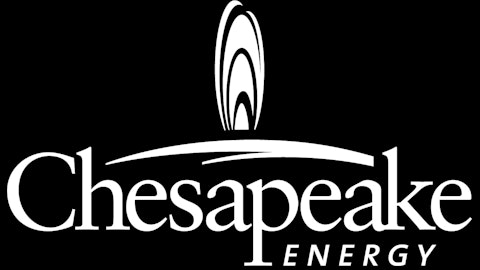Following a recent joint venture agreement with Chinese oil company Sinopec Shanghai Petrochemical Co. (ADR) (NYSE:SHI), Chesapeake Energy Corporation (NYSE:CHK) is back to contemplating which asset it will part with next, as the company seeks to plug a sizable funding gap.

With that deal wrapped up, Chesapeake is hoping for more favorable terms on future asset sales. The company’s onerous debt situation, which has pushed its cost of capital higher, makes it all the more urgent to whittle down its funding gap as quickly as possible.
Looking ahead, Chesapeake Energy Corporation (NYSE:CHK) could sell parts of its undeveloped acreage in plays such as the Eagle Ford, the Utica, the Marcellus, the Haynesville, and the Powder River/DJ Basin. Let’s take a closer look at which of these assets might be next to go.
Potential gassy assets up for sale
Analysts at JP Morgan upgraded Chesapeake Energy Corporation (NYSE:CHK) in January, suggesting that the company may have another major asset sale opportunity “up its sleeve.” In a research note, the bank highlighted the company’s Marcellus and Haynesville assets as prime candidates for divestiture.
In the gassy Haynesville Shale play of northwest Louisiana and East Texas, Chesapeake holds the title of largest leaseholder, with roughly 530,000 net acres, of which 195,000 net acres are prospective for the Bossier Shale, a formation that lies directly above the Haynesville.
And in the Marcellus Shale, Chesapeake Energy Corporation (NYSE:CHK) is also the largest leasehold owner with 1.8 million net acres under its belt. The majority of this acreage – about 1.5 million – is in the northern dry gas portion of the play, while the remaining acreage is in the southern “wet gas” portion of the play. The company currently has five rigs operating in the dry gas portion and three rigs operating in the wet gas portion.
Experts think Marcellus assets next to go
In considering future asset sales, it would make more sense for Chesapeake Energy Corporation (NYSE:CHK) to part with a large block of undeveloped acreage, since selling producing acreage by itself would not only lead to a sharp reduction in cash flow, but also wouldn’t be accretive to multiples, according to a recent note by TPH Energy Research.
Given these criteria, TPH analysts believe the Marcellus is likely to be the next gassy asset to go. They estimate that Chesapeake’s acreage in the Marcellus could fetch $8 billion before tax or $6.4 billion after tax. While this would cover the company’s funding gap for the year, it would have negative consequences for Chesapeake Energy Corporation (NYSE:CHK)’s cash flow and aggregate production.
TPH estimates that a sale of Chesapeake’s Marcellus assets would lower 2013 cash flow by up to $600 million, while simultaneously reducing total production by 22%. It would also worsen the company’s cost structure by reducing gas differentials by up to 15%, according to the firm’s calculations.
Issues with selling natural gas assets
But selling natural gas assets at a time when most natural gas wells are uneconomical is probably a sure path to getting ripped off. With natural gas prices currently hovering near $3.50 per thousand cubic feet, virtually no energy producer wants to be developing Haynesville acreage. The steady downward trend in the Haynesville rig count is the most obvious evidence of this.
A similar trend is unfolding in the dry gas portion of the Marcellus, with producer after producer pulling their rigs from the area. EXCO Resources Inc (NYSE:XCO) , for instance, has slashed its rig count from four to one and is heavily downsizing its regional headquarters. Similarly, Talisman Energy Inc. (USA) (NYSE:TLM) , which also currently only has one rig running in the play, has reduced its capital allocation to the Marcellus by 65% and instead has diverted its focus to the oilier Eagle Ford Shale in Texas.
However, the wet gas window of the Marcellus continues to see relatively strong drilling activity. For instance, Range Resources Corp. (NYSE:RRC) is planning on directing roughly 80% of its $1.3 billion capital budget toward drilling operations in the Marcellus. Thanks to the superior economics of the wet gas portion of the play, the company has realized higher profit margins for its natural gas liquids production.
Final thoughts
Some analysts expect Chesapeake to become much more aggressive in its attempts to meet its year-end divestiture target. Analysts at Stifel Nicolaus, a brokerage and investment banking firm, wrote in a note to investors that “with the new management team, the company will be hitting the bids on asset sales rather than holding on to assets if the bids are not close to the underlying value.”
Between the Haynesville and the Marcellus, it would probably make more sense for Chesapeake to part with its Marcellus acreage, since its Haynesville assets would likely fetch an undesirable price. Due to relatively higher demand for drilling in certain portions of the Marcellus, Chesapeake’s assets there would likely sell for a price closer to the company’s estimates of potential value.
Alternatively, it may also make sense for Chesapeake to part with some of its undeveloped acreage in liquids-rich plays, especially the Eagle Ford, where the company reckons an acre should easily fetch upwards of $30,000. Other liquids plays that the company thinks should be able to generate strong proceeds include the Utica Shale, where Chesapeake lays claim to roughly 900,000 net acres, and the Anadarko Basin, where it commands one million net acres.
The article Which Asset Will Chesapeake Sell Next? originally appeared on Fool.com.
Fool contributor Arjun Sreekumar has no position in any stocks mentioned. The Motley Fool recommends Range Resources. The Motley Fool has the following options: Long Jan 2014 $20 Calls on Chesapeake Energy, Long Jan 2014 $30 Calls on Chesapeake Energy, and Short Jan 2014 $15 Puts on Chesapeake Energy.
Copyright © 1995 – 2013 The Motley Fool, LLC. All rights reserved. The Motley Fool has a disclosure policy.





